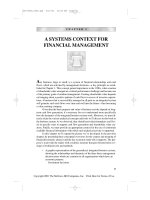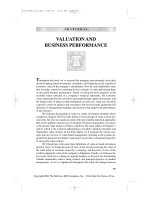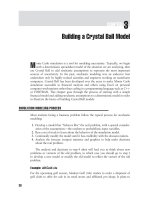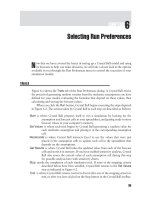Financial Modeling with Crystal Ball and Excel Chapter 2 ppsx
Bạn đang xem bản rút gọn của tài liệu. Xem và tải ngay bản đầy đủ của tài liệu tại đây (444.23 KB, 17 trang )
CHAPTER
2
Analyzing Crystal Ball Forecasts
I
n this chapter, using an example of accumulating funds for retirement, we see
the graphical and numerical summaries of forecasts that Crystal Ball provides
automatically. This chapter serves as a review of elementary statistical analysis,
focused on the standard output built into Crystal Ball.
SIMULATING A 50–50 PORTFOLIO
Let’s say that you want to start saving for your retirement. You are 30 years old and
wish to retire at age 60. You plan to put away an inflation-adjusted $10,000 per
year, and would like to know how much wealth you will have accumulated after 30
years. At this point, you consider only two types of assets: stocks and bonds.
If you had perfect foresight, you would know exactly what returns each
investment would bring over the next 30 years. With that information, you wouldn’t
need Crystal Ball and could optimize your portfolio by investing in only those assets
that you knew would go up. Of course, no one has perfect foresight, so what do you
do? In this chapter, we’ll consider an oversimplified model for investing retirement
funds and use it to illustrate how to analyze Crystal Ball forecasts.
Accumulate.xls
Overview. For this model we assume that returns on stocks and bonds during
the next 30 years will resemble (in a statistical sense) the returns that
have been observed during the years 1926 to 2004. You have heard that
diversification is a good thing to do when investing your money, so you
decide initially to split the money you want to set aside for retirement each
year by putting one half into stocks and one half into bonds. We call this
the 50–50 portfolio, and model it in the Excel file Accumulate.xls.
The model draws returns on stocks and bonds randomly for each year and
calculates the wealth you will have accumulated for retirement 30 years
from now, assuming a constant 3 percent inflation rate. A segment of this
model is shown in Figure 2.1. Note that rows 14 through 40 are hidden to
save space.
11
12 FINANCIAL MODELING WITH CRYSTAL BALL AND EXCEL
FIGURE 2.1 Spreadsheet segment from Accumulate.xls showing accumulated value after 30 years of
retirement savings where 50 percent was put into stocks and 50 percent into bonds each year. Note that
Rows 14 through 40 are hidden.
Forecast. You want to see the possible distribution of wealth you will have
accumulated after 30 years—Year 30 Wealth. Cell D4 has the formula
=H41 to get Year 30 Wealth displayed near the top of the spreadsheet.
Stochastic assumptions. Cells B12:B41 represent the total annual return on
stocks for years 1 through 30. Each year’s return on stocks is lognormal
with mean 1.1517 and standard deviation 0.2746. Cells C12:C41 represent
the total annual return on bonds for years 1 through 30. Each year’s return
on bonds is lognormal with mean 1.0585 and standard deviation 0.0735. In
this model, all assumptions are statistically independent of each other (that
is, all correlations are zero). The parameters of the lognormal distributions
were chosen with the help of Crystal Ball’s distribution-fitting feature, which
is described in Chapter 4.
Decision variable. The sole decision variable in this model is Cell B4, the pro-
portion of each year’s investment that is allocated to stocks. The proportion
allocated to bonds is calculated in Cell B5 as =1–B4 to ensure that the
entire investment is put into either stocks or bonds each year. The initial
proportion allocated to stocks is 50 percent.
Summary. Figure 2.2 shows the frequency view of a forecast chart for Year 30
Wealth obtained after running the simulation for 10,000 trials. Note that
the distribution is highly skewed to the right because of a few instances of
very high returns over the 30-year period.
Frequency Chart
The default graph in the Forecast window is a frequency chart (also known as a
histogram) that shows how often a forecast cell had a value falling in each of several
possible intervals. In the forecast window for Year 30 Wealth in Figure 2.2, the
possible values range from $0 to $15 million, and are broken up into 15 equal
Analyzing Crystal Ball Forecasts
13
FIGURE 2.2 Frequency chart showing accumulated value after 30 years
of retirement savings where 50 percent was put into stocks and 50 percent
into bonds each year. The estimated probability of accumulating between
$1 million and $2 million is shown in the Certainty field.
intervals (of size $1 million). The height of each bar indicates how many simulation
trials resulted in a Year 30 Wealth value that fell in the corresponding interval.
For example, the tallest bar in Figure 2.2 indicates that Year 30 Wealth was
between $1 million and $2 million in just fewer than 3,600 trials. The right side of
the histogram has the frequency scale. Because there were 10,000 trials run, and the
estimated probability (certainty) of Year 30 Wealth being between $1 million and
$2 million is 34.47 percent, we know that there must have been 3,447 trials that
resulted in Year 30 Wealth between $1 million and $2 million. The left side of the
histogram has the probability scale. The text ‘‘9,761 Displayed’’ in the upper right
corner of the window indicates that Year 30 Wealth was greater than $15 million
(literally, ‘‘off the chart’’) on 239 of the 10,000 simulation trials run. We know
that all of the undisplayed values must be above $15 million rather than below $0
because the portfolio value can never be negative under the assumptions we used.
Cumulative Frequency Chart
Change the forecast window by clicking on Preferences, Forecast , then selecting
Cumulative Frequency in the View field and clicking OK. You may also click on
View → Cumulative Frequency in the top menu of the forecast window. The cumu-
lative frequency chart in Figure 2.3 shows the frequency with which the simulation
trials fell into each interval or below. For example, from the cumulative frequency
14 FINANCIAL MODELING WITH CRYSTAL BALL AND EXCEL
FIGURE 2.3 Cumulative frequency chart showing accumulated value
after thirty years of retirement savings where 50% was put into stocks
and 50% into bonds each year. The estimated probability of
accumulating more than $1 million is shown in the Certainty field.
chart you can see that in 80.09 percent of the trials, 30-year wealth had a value below
$5 million. Another way to interpret this example is to say that the estimated prob-
ability is approximately 80 percent that 30-year wealth will be less than $5 million.
Note that Crystal Ball also provides a reverse cumulative frequency chart (not
pictured here) that shows the frequency with which the simulation trials fell into
each interval or above. You can cycle through the different views by using the
keystroke combination Ctrl-d when the forecast window is active. Table 2.1 lists
the keystroke combinations (sometimes called ‘‘hot keys’’ or ‘‘keyboard shortcuts’’)
that are available to alter your view of the forecast window. Make the Year 30
Wealth forecast window active and experiment with different combinations to see
the effects.
Statistics View
The statistics view of the Forecast window in Figure 2.4 provides numerical sum-
maries of the forecast. Descriptions of the statistics computed automatically by
Crystal Ball in Figure 2.4 are listed below. The number of each statistic in the
list can be used in the Excel formula =CB.GetForeStatFn(Range,Index) as the
value of Index. The statistics and their indices are also listed in Table 4.1, and
usage of the =CB.GetForeStatFn(Range,Index) is illustrated in Cells D46:E57 in
Accumulate.xls.
Analyzing Crystal Ball Forecasts
15
TABLE 2.1 Keystroke combinations (‘‘hot keys’’) thatcanbeusedtocyclethroughsettings
available in the Chart Preferences dialog. These commands work on the primary
distribution—the theoretical probability distribution for assumptions, and the generated
values for forecasts and overlay charts.
Hot Key Description
Ctrl-d Cycles through chart views: Frequency, Cumulative Frequency, Reverse Cumu-
lative Frequency (for assumption and forecast charts)
Ctrl-b
or Ctrl-g
Cycles through bins or group interval values to adjust the number of data bins
used to create the chart
Ctrl-l Cycles through gridline settings: None, Horizontal, Vertical, Both
Ctrl-t Cycles through chart types: Area, Line, Column; for sensitivity charts: Bar
(direction), Bar (magnitude), Pie (in Contribution to Variance view)
Ctrl-3 Cycles between two-dimensional and three-dimensional chart display
Ctrl-m Cycles through central tendency marker lines: None, Base Case, Mean, Median,
Mode (except for sensitivity and trend charts)
Ctrl-n Toggles the legend display on and off
Ctrl-p Cycles through percentile markers: None, 10%, 20%, , 90%
Spacebar Cycles through window views when Excel is not in Edit mode: Chart, Statistics,
Percentiles, Goodness of Fit (if distribution fitting is selected—except for trend
charts)
For the mathematical expressions in the list below, we denote the values
produced by the simulation in a forecast cell as y
1
, y
2
, , y
n
,wheren is the number
of iterations run before the simulation stops.
1. Trials. The first item listed in the statistics view is Trials, which is also called
the number of iterations, n. A trial (or iteration) is a three-step process in which
Crystal Ball generates a random number for each assumption cell, recalculates
the spreadsheet model(s), and collects the result(s) for the forecast window(s).
The number of trials is the only descriptive statistic value that is under your
direct control. Use the Run Preferences dialog box to specify the maximum
number of trials.
2. Mean. The next item in the Statistics View is Mean, which is the same as the
arithmetic average. It is calculated as
Mean =
Y =
1
n
n
i=1
y
i
.
Even though the window indicates that only 9,761 trials are displayed, the value
$3,775,824 for the mean in Figure 2.4 is calculated from all 10,000 trials of the
simulation.
16 FINANCIAL MODELING WITH CRYSTAL BALL AND EXCEL
FIGURE 2.4 Forecast chart statistics for accumulated value after 30 years
of retirement savings where 50 percent was put into stocks and 50 percent
into bonds each year.
If you wish to calculate statistics for selected values of the forecast, click on
Preferences, Forecast , then the Filter tab. You will be able to include or
exclude any specified range of values from the calculations. This feature will
come in handy later for calculating expected tail loss.
The mean is one of three measures of location computed by Crystal Ball. The
other two measures of location are the median and the mode. In a highly skewed
distribution such as Year 30 Wealth, the mean may not be the best indication of
the location of the distribution. Use the certainty range in the forecast chart to
see for yourself that the probability of Year 30 Wealth equalling or exceeding
the mean is only about 30 percent.
3. Median. The median is the value in the middle of the distribution. For example,
6 is the median of the distribution of values 1, 3, 6, 7, and 9. In a distribution
with an odd number of values, the median is found by ordering the values from
smallest to largest and then selecting the middle value. In a distribution with
an even number of values, the median is equal to the mean of the two middle
ordered values.
For Year 30 Wealth, the median value in Figure 2.4 is $2,425,951, which means
that the probability is about 50 percent that our retirement portfolio will be
that large or larger at that time. The median is less sensitive to outliers than the
mean. For that reason, it is sometimes preferred to the mean as a measure of
location, as it is here because the Year 30 Wealth forecast frequency distribution
is highly skewed.
Analyzing Crystal Ball Forecasts
17
4. Mode. The mode is the single value that occurs most frequently in a set of
values. For a forecast that can take on continuous values, it is likely that no
single value will occur more than once, so the mode is often listed as dashes
(––) in the statistics view, as it is in Figure 2.4.
5. Standard Deviation. The standard deviation is a measure of dispersion, or
spread, of a distribution. Think of it as roughly equal to the average distance of
each value from the mean, although as you can see in the formula below, it is
not exactly equal to that:
Standard Deviation = s =
1
n −1
n
i=1
(
y
i
−y
)
2
. (2.1)
The standard deviation is one of two equivalent measures of spread computed by
Crystal Ball. The other measure of spread is the variance. In many applications,
the standard deviation is preferred because it is measured in the same units as
the forecast variable.
6. Variance. The variance is another measure of dispersion that is equivalent to
the standard deviation. Because the variance is equal to the standard deviation
squared, it sometimes appears in the statistics view as a very large number. The
variance is calculated as:
Variance = s
2
=
1
n −1
n
i=1
(y
i
−y)
2
.
7. Skewness. Skewness is a measure of asymmetry of a frequency distribution.
The distributions pictured in Figure 2.5 display negative, positive, and near-zero
skewness. The formula for skewness used by Crystal Ball is
Skewness =
1
n
n
i=1
y
i
−y
s
3
.
The large positive skewness of Year 30 Wealth can be seen in Figure 2.2, and is
measured as 32.20 in Figure 2.4. The fact that the mean of $3.776 million is so
much larger than the median of $2.426 million is also evidence of large positive
skewness. Alternative measures of skewness are
3(Mean −Mode)
Standard Deviation
and
3(Mean −Median)
Standard Deviation
,
either of which you can calculate easily from the Crystal Ball output.
With all else equal, positive skewness in accumulated wealth is desirable;
however, note that here the large positive skewness makes it misleading to
expect to earn the mean wealth. As calculated above, there is less than a 30
percent chance that you will actually accumulate the mean wealth or more.
18 FINANCIAL MODELING WITH CRYSTAL BALL AND EXCEL
FIGURE 2.5 Frequency distributions depicting negative (Skewness =−2), positive (+2), and near-zero
(0.02) skewness at top left, top right, and bottom center, respectively.
8. Kurtosis. Kurtosis is a measure of peakedness, which is equivalent to measuring
tail thickness. The formula for kurtosis used by Crystal Ball is
Kurtosis =
1
n
n
i=1
y
i
−y
S
4
.
If two distributions have the same standard deviation, the one with the higher
kurtosis will have a higher peak and heavier tails. All normal distributions
have a kurtosis of 3.0, and frequency distributions with a kurtosis near 3.0 are
called mesokurtic. Distributions that have significantly higher kurtosis are called
leptokurtic and those with significantly lower kurtosis are called platykurtic.
Some computer programs and authors subtract 3.0 from the definition above
used by Crystal Ball. The technical name for this is then excess kurtosis, but
you may see it too called kurtosis by some authors, so beware. In fact, the
statistic calculated by Excel’s =KURT(ref) command and its Data Analysis tool is
actually excess kurtosis—calculated by a slightly different formula than Crystal
Ball—but is labelled simply as kurtosis.
Figure 2.6 shows an overlay chart for two distributions that have mean zero
and standard deviation one. The distributions with the lower peak is the
standard normal distribution, which has kurtosis = 3.0, as does every normal
distribution. The distribution labeled Mixture has kurtosis = 12.1. It could have
come from a market in which 5% of the time returns have high variability and
95 percent of the time they have low variability (see the file Kurtosis.xls for
details).
Analyzing Crystal Ball Forecasts
19
FIGURE 2.6 Overlay chart depicting a mesokurtic standard normal distribution (kurtosis = 3) and a
leptokurtic mixture distribution (kurtosis = 11.7). See the file Kurtosis.xls for details.
9. Coefficient of Variability. The coefficient of variability, also known as the coef-
ficient of variation, is a relative measure of dispersion found as
Coefficient of Variability =
s
y
.
It might be more useful than standard deviation for some purposes. For example,
a standard deviation of 10 may be insignificant if the mean is 10,000 (giving
a coefficient of variability = .001) but may be substantial if the mean is 100
(coefficient of variability = .1). Because the mean
y and standard deviation s
have the same units, the coefficient of variability is dimensionless.
Crystal Ball calculates it routinely as part of the standard output, but the coeffi-
cient of variability is best used only when all simulated values are positive. When
the values can be both positive or negative, the mean can be zero or negative.
When the mean value is near zero, the coefficient of variability is sensitive to
small changes in the standard deviation, which can limit its usefulness. When
the mean value is negative, use the absolute value of the coefficient of variability
to get a more meaningful relative measure of dispersion.
10. Minimum. The minimum is the smallest value of all the observed forecast values.
Note for models using unbounded-on-the-left stochastic assumptions such as
the normal distribution, the more trials that are run, the smaller the minimum
is likely to be simply because there are more opportunities for Crystal Ball to
generate extreme observations.
20 FINANCIAL MODELING WITH CRYSTAL BALL AND EXCEL
FIGURE 2.7 Plot of 100/
√
n for n in the interval [100, 10000]. This plot
shows how the standard error of the mean decreases as a function of the
number of trials in the simulation. Much of the decrease in standard error is
gained after only 2,000 trials.
11. Maximum. The maximum is the largest value of all the observed forecast values.
For assumptions that are unbounded on the right such as the normal or lognor-
mal distributions, the more trials that are run, the larger the maximum is likely
to be simply because there are more opportunities for Crystal Ball to generate
extreme observations.
12. The Range is the difference between the minimum and the maximum. In
versions of Crystal Ball before 7.2, the Range was listed in the statis-
tics view of the forecast window. For backward compatibility, the com-
mand =CB.GetForeStatFN(range,12) will return the Range statistic, which
is simply the Minimum subtracted from the Maximum. Do not confuse the
CB.GetForeStatFN argument range, which represents the address of a forecast
cell, with the Range statistic described here.
13. Mean Standard Error. The mean standard error is a measure of precision of
the estimate of the mean. The smaller the mean standard error, the greater
the precision. Figure 2.7 shows how the mean standard error decreases in a
nonlinear manner as the number of trials increases for a forecast distribution
having a standard deviation of 100. Most of the precision in the estimate is
gained by 2,000 trials.
Forecast Window Percentiles View
The percentiles view in Figure 2.8 gives the forecast values that are just larger than
the corresponding percent of all the values. For example, the 80th percentile for
Year 30 Wealth is $4,985,234. This means that 80 percent of the forecast values
were less than that amount, while 20 percent were greater than that amount. Note
Analyzing Crystal Ball Forecasts
21
FIGURE 2.8 Forecast chart percentiles for accumulated value after 30
years of retirement savings where 50 percent was put into stocks and 50
percent into bonds each year.
that the 50th percentile of $2,425,951 is the same as the value of the median in
Figure 2.4.
VARYING THE ALLOCATIONS
We started with a simple example of allocating 50 percent to each type of fund,
which we call the 50–50 portfolio. Now we will compare forecasts for different
allocations of stocks and bonds to the portfolio.
Decision Table Tool
In file Accumulate.xls, select cell B4,thenclickonDefine > Define Decision Fill
in the fields in the Define Decision Variable dialog as shown in Figure 2.9. Click
OK and watch cell B4 turn yellow to indicate that a Crystal Ball decision variable is
defined there. After this definition, you can use the Decision Table tool to vary the
allocation into stocks from 10% to 90% in steps of 10%.
Click on Run > Tools > Decision Table IntheSpecify target (step 1 of 3)
dialog, Year 30 Wealth will be the only forecast listed (Figure 2.10), so click Next >.
In the Select one or two decisions (step 2 of 3) dialog, Stocks will be the only
available decision variable. Move this rightward to the Chosen Decision Variables
window by clicking >> (Figure 2.11), then click Next >.
22 FINANCIAL MODELING WITH CRYSTAL BALL AND EXCEL
FIGURE 2.9 Dialog window showing settings to specify nine different
allocations into stocks each year. The allocation to stocks varies from 10
percent to 90 percent in steps of 10 percent.
FIGURE 2.10 Step 1 in using the Decision Table tool.
Analyzing Crystal Ball Forecasts
23
FIGURE 2.11 Step 2 in using the decision table tool.
The Specify options (step 3 of 3) dialog should look like Figure 2.12. Specify
2000 trials as shown in Figure 2.12 and click Start. Crystal Ball will run 2,000 trials
for each of the nine allocations.
When Crystal Ball finishes its decision table analysis, you should see a new
worksheet with nine Crystal Ball forecasts in cells B2:J2. The value in each cell
is the mean of the forecast for Year 30 Wealth for the corresponding allocation to
stocks that appears in Row 1 of the worksheet.
Trend Chart
Select cells B2:J2, then click Trend Chart. Your trend chart should look like that
depicted in Figure 2.13, which clearly shows how the risk and expected reward
increases as you increase your allocation to stocks.
The certainty bands in Figure 2.13 are centered on the median, so for each of
the nine allocations listed on the horizontal axis, the 10 percent band extends from
the 45th to 55th percentile, the 25 percent band extends from the 37.5th percentile
to the 62.5th percentile, the 50 percent band extends from the 25th percentile to
the 75th percentile, and the 90 percent band extends from the 5th to the 95th
24 FINANCIAL MODELING WITH CRYSTAL BALL AND EXCEL
FIGURE 2.12 Step 3 in using the Decision Table tool.
FIGURE 2.13 Trend chart comparing accumulated values after 30 years of
retirement savings for nine different allocations into stocks and bonds each year.
Year 30 Wealth (1) represents a 10 percent allocation to stocks—the 10–90
portfolio, Year 30 Wealth (2) represents a 20 percent allocation to stocks—the
20–80 portfolio, ,andYear 30 Wealth (9) represents a 90 percent allocation to
stocks—the 90–10 portfolio.
Analyzing Crystal Ball Forecasts
25
FIGURE 2.14 Overlay chart comparing accumulated value after 30 years of retirement savings for two
different allocations into stocks and bonds each year. Year 30 Wealth (5) represents a 50 percent
allocation to stocks and 50 percent allocation to bonds, and Year 30 Wealth (9) represents a 90 percent
allocation to stocks and 10 percent allocation to bonds.
percentile of each forecast distribution. The slopes of the lines connecting each of
these percentiles provide insight into the behavior of the wealth distribution as we
vary the portfolio allocations to stocks and bonds.
The facts that the spread of the lines increases and that seven of the eight lines
(all but the 5th percentile line) are sloped upwards indicate that greater allocation to
stocks provides greater upside potential for Year 30 Wealth. The negative slope of
the 5th percentile line indicates slightly greater downside risk as more of the portfolio
is allocated to stocks, but for many investors this downside risk is outweighed by
the much greater upside potential.
Overlay Chart
In the worksheet created by Crystal Ball’s decision table analysis, select cell F2,
then hold down the Ctrl Key and click on cell J2. Next, click on Overlay Chart.
Use the hot keys Ctrl-t and Ctrl-d to make your chart look like that in Figure 2.14,
which compares the risk profiles of a 50–50 portfolio to a 90–10 portfolio. The
risk profiles are line graphs depicting the probability on the vertical axis that each
portfolio yields a Year 30 Wealth greater than the corresponding monetary value on
the horizontal axis.
26 FINANCIAL MODELING WITH CRYSTAL BALL AND EXCEL
FIGURE 2.15 Overlay chart comparing accumulated value after 30 years of retirement savings for two
different allocations into stocks and bonds each year. Year 30 Wealth (1) represents a 10 percent
allocation to stocks and 90 percent allocation to bonds, and Year 30 Wealth (9) represents a 90 percent
allocation to stocks and 10 percent allocation to bonds.
The 90–10 portfolio almost completely dominates the 50–50 portfolio in the
sense that the line representing the 90–10 portfolio is above and to the right of the
50–50 line almost everywhere. For Year 30 Wealth values below about $1 million,
the lines are virtually indistinguishable. While very risk-averse investors might prefer
the 50–50 portfolio because it dominates the 90–10 portfolio slightly in the worst
10 percent of the cases, most investors would prefer the 90–10 portfolio’s wealth
distribution because of its near equivalence in the lowest 10 percent and dominance
in the upper 90 percent of the potential returns.
Figure 2.15 presents information comparing the 90–10 portfolio to the 10–90
portfolio that is similar to that provided by Figure 2.14 for comparing the 50–50
portfolio to the 90–10 portfolio. However, because Figure 2.15 is a cumulative
frequency chart, the near dominance of the 90–10 portfolio is manifested by the
90–10 line lying to the right and below the line for the 10–90 portfolio for Year 30
Wealth values above $1 million.
Analyzing Crystal Ball Forecasts
27
PRESENTING THE RESULTS
The example in this chapter illustrates both positive and negative aspects of simula-
tion analysis.
On the positive side, Crystal Ball provides a clear picture of the entire distribution
of results with views that can be easily selected to suit the tastes of your audience. For
example, some people prefer frequency distributions, while others prefer cumulative
or reverse cumulative distributions. The statistics window automatically displays
most of the descriptive statistics that decision makers might be interested in seeing.
The percentiles window and trend chart present views that can also be helpful for
interpreting and comparing output distributions. This lets decision makers compare
forecasts on a wide variety of dimensions.
A negative aspect is that output distributions can be compared on so many
dimensions. Until you become accustomed to thinking about distributions of results
rather than single measures such as the mean or median, trying to interpret the
output can be somewhat overwhelming.
Crystal Ball gives you the ability to present the output in a wide variety of ways.
Selecting the best way to communicate your results is a skill that requires some effort
on your part to acquire. This book provides many examples of using Crystal Ball as
a decision tool. Working through the examples and generating the output on your
computer as you read will help you decide what is best for you and your clients.









